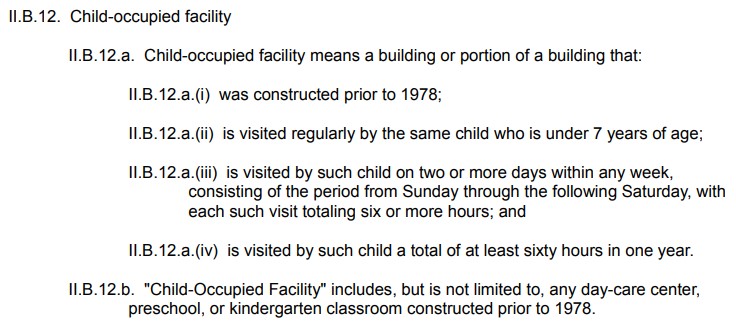If you’re a contractor, property manager, or even a landlord working on pre-1978 housing or child-occupied facilities in Colorado, you might be asking yourself if the Lead-Based Paint Pre-Renovation Education Rule (Lead PRE) applies to you. It’s an essential regulation designed to protect residents—especially children and pregnant women—from the dangers of lead exposure during renovation or repair work. Let’s break down what this rule is and who needs to follow it.
What is the Lead-Based Paint Pre-Renovation Education Rule (Lead PRE)?
The Lead PRE rule is a Colorado regulation that affects renovation, repair, and painting work in homes and child-occupied facilities (such as daycares or preschools) built before 1978. Its primary goal is to inform residents and facility occupants about the potential hazards of lead exposure, which can cause severe health issues, particularly in young children and pregnant women. The rule requires specific practices to be followed before and during renovations to prevent lead contamination.
What are Colorado’s Lead PRE Requirements?
Here’s what you need to keep in mind if you’re performing work that falls under the Lead PRE rule:
For Work in Single-Family Homes or Individual Apartments:
- Distribute the “Renovate Right” Pamphlet: You must provide this EPA-approved pamphlet to housing owners and occupants before starting any work.
- Recordkeeping: Keep records of distributing the pamphlet for at least three years.
For Work in Common Areas of Multi-Family Housing:
- Renovation Notices: You can either hand out renovation notices to tenants or post signs at the job site clearly describing the nature and extent of the work.
- Recordkeeping: As with single-family homes, maintain records for three years.
For Work in Child-Occupied Facilities (e.g., Daycares, Preschools):
What is a Child-Occupied Facility?
A building or portion of a building built before 1978 and is visited regularly by a child under 7 years. If a child visits two or more days per week (Sun-Sat), with each visit lasting six or more hours – or, if the facility is visited by a child at least 60 hours per year.

You can see the full version of the bill here.
- Pamphlet Distribution: Provide the “Renovate Right” pamphlet to the building owner and an adult representative of the child-occupied facility.
- Parental Notification: Inform parents or guardians of children under the age of 7 about your project by mailing them information, delivering it by hand, or posting signs in common areas.
- Recordkeeping: Keep these records for at least three years.
By following these steps, you’re not only complying with state law but also taking meaningful steps to protect the health and safety of the people living in or using the spaces where you’re working.
Who Must Follow These Requirements?
In general, if your work disturbs more than 2 square feet of a lead painted surface, in pre-1978 housing or child-occupied facilities, and you’re compensated for that work (even if it’s through bartering or as part of property management), the Lead PRE rule likely applies to you. This means:
- Home Improvement Contractors
- Landlords
- Property Managers
- Apartment Maintenance Staff
- Renovators and Remodelers
- Electricians, Plumbers, Painters, Carpenters
- Restoration Companies
Essentially, if your job involves disturbing more than 2 square feet of painted surfaces in buildings that fit the criteria, you’re on the hook for complying with this regulation.
Exclusions from Colorado’s Lead PRE
While many renovation projects fall under the Lead PRE rule, some work is excluded. You don’t need to comply with Lead PRE if:
- The project is in zero-bedroom dwellings (e.g., studio apartments, barracks or dormitories).
- You’re conducting emergency renovations or repairs.
- The housing or components have been declared lead-free by a certified lead inspector or risk assessor.
- The property is housing for the elderly or disabled, provided no children will be living there.

Do Any of the Following Apply to Your Project?
Before you assume the Lead PRE rule applies to your work, ask yourself these questions:
- Is the work an emergency renovation?
- Is the work a lead abatement project (a different category from renovation)?
- Does the work involve minor repairs disturbing 2 square feet or less of painted surfaces?
- Have the child-occupied facility, housing, or affected components been determined to be lead-free by a certified inspector or risk assessor?
- Is the property a zero-bedroom dwelling or housing for the elderly or disabled without children?
If any of the above conditions apply, you might be exempt from the Lead PRE requirements. However, if none of these apply, you’ll need to follow the rule and distribute the “Renovate Right” pamphlet.
Why This Matters
Lead exposure, especially in older homes and facilities, is a serious issue that can lead to long-term health problems. The Lead PRE rule is designed to protect residents and occupants from the dangers of lead dust and chips during renovation projects. By following the Lead PRE requirements, you’re not just complying with the law—you’re actively contributing to public health and safety.
So, before you pick up that paint scraper or power drill, make sure you know if the Lead PRE rule applies to your project. If you’re unsure, give Integrity Environmental Testing & Consulting a shout. We specialize in helping contractors, property managers, and homeowners stay compliant with lead regulations while keeping their properties safe. Contact us today for expert advice and testing services.
